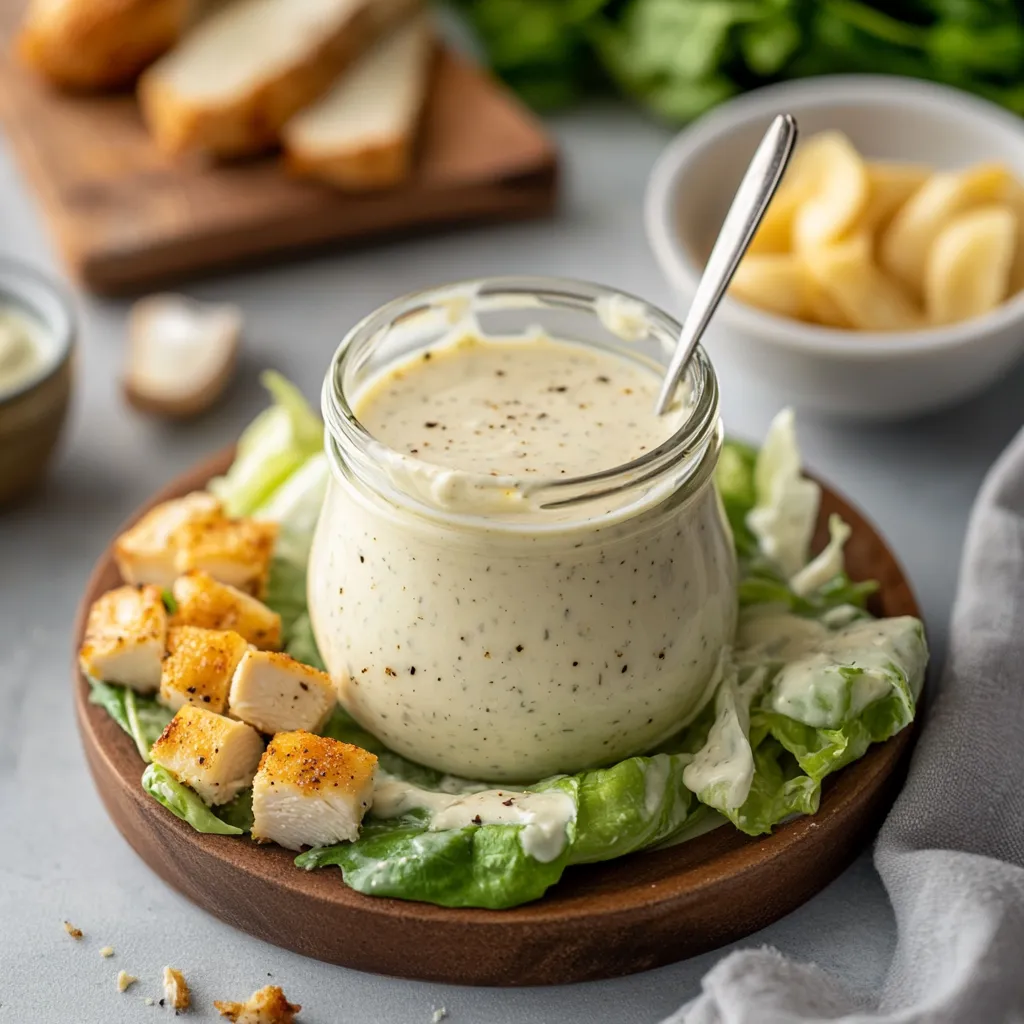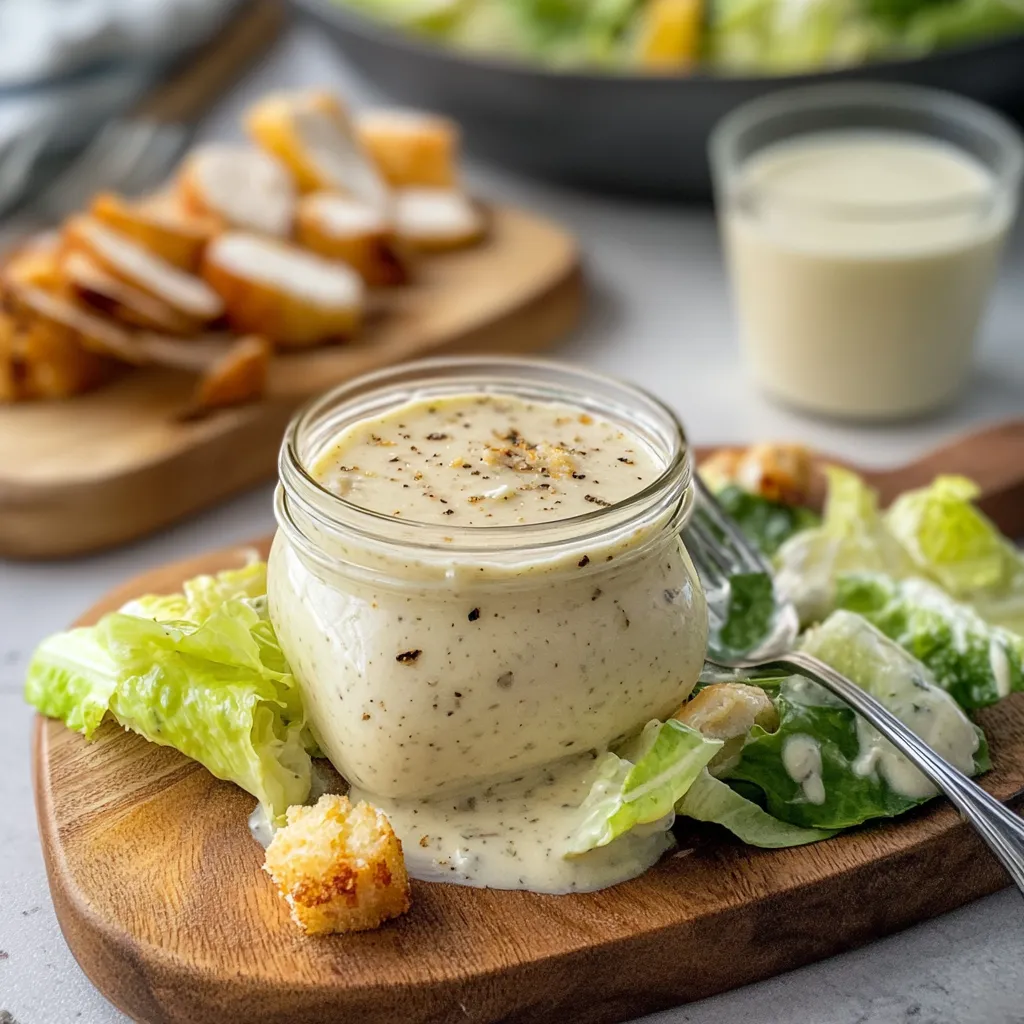Homemade Caesar Salad Dressing Recipe: Creamy & Delicious

If you’ve ever tasted a truly exceptional Caesar salad, you know that the secret lies in the dressing. This Homemade Caesar Salad Dressing Recipe brings together the rich umami of anchovies, the sharp tang of garlic, and the creaminess of Parmesan to create a flavor symphony that elevates your greens to new heights. What’s more, crafting your own dressing is an exercise in creativity. You can adjust the garlicky intensity, the creaminess, or even swap in unique ingredients like yogurt for a lighter touch or vegan options for a plant-based twist.
To ensure you achieve the perfect balance, consider using fresh ingredients—freshly squeezed lemon juice and high-quality olive oil can make all the difference. Don’t hesitate to experiment with spices or add a hint of Worcestershire sauce to kick things up a notch. Whipping up this dressing not only promises to enhance your salads but also allows you to impress your friends and family with your culinary prowess. Let’s dive into the delicious journey of making your own Homemade Caesar Salad Dressing Recipe!
Ingredients for Homemade Caesar Salad Dressing Recipe:
This velvety Caesar salad dressing is not only delicious but also simple to prepare. Below are the ingredients needed to serve 8-10 people:
Base Ingredients
- 2 cups mayonnaise – A good quality mayonnaise serves as the creamy base for the dressing.
- 1/4 cup freshly squeezed lemon juice – Adds brightness and acidity to balance the richness of the mayonnaise.
- 1 tablespoon Dijon mustard – This ingredient brings depth and a subtle zing to the flavor profile.
- 2 tablespoons Worcestershire sauce – Adds a savory umami kick that is essential in authentic Caesar dressing.
Garlic and Anchovy Components
- 3 cloves garlic, minced – Fresh garlic gives the dressing its unmistakable flavor.
- 4 anchovy fillets, finely chopped – These are optional but recommended for that classic Caesar taste. If desired, substitute with 1 teaspoon of anchovy paste.
Cheese and Seasoning
- 1/2 cup grated Parmesan cheese – Use freshly grated cheese for the best texture and flavor.
- 1 teaspoon freshly ground black pepper – This enhances the flavor and adds a touch of spice.
- 1 teaspoon salt – Adjust according to your preference, but remember that Parmesan is salty as well.
- 1/4 cup high-quality olive oil – This helps to emulsify the dressing and adds richness.
Recommended Variations
- If you prefer a vegan dressing, substitute mayonnaise with aquafaba (chickpea brine) and nutritional yeast instead of cheese.
- For a spicy kick, consider adding a teaspoon of hot sauce or a pinch of cayenne pepper.
- Incorporate fresh herbs like basil or parsley for a unique flavor twist.
Gathering these ingredients will set you on the path to creating a truly delicious dressing, perfect for drizzling over crisp romaine lettuce or using as a dip for vegetables.

How to prepare Homemade Caesar Salad Dressing Recipe:
Creating your tasty Caesar salad dressing at home can be simple. Follow these clear steps for the best results.
Gather Your Ingredients
Start by assembling all the required ingredients to make your dressing. You will need fresh garlic, egg yolks, Dijon mustard, lemon juice, Worcestershire sauce, olive oil, and grated Parmesan cheese. Having everything ready ensures a smooth preparation process.
Prepare the Garlic
Take two cloves of fresh garlic and finely mince them. The garlic is essential for that signature flavor, so ensure it’s chopped well for even distribution.
Combine Egg Yolks and Flavorings
In a medium mixing bowl, add two egg yolks. These provide richness to the dressing. Next, mix in one teaspoon of Dijon mustard and two teaspoons of Worcestershire sauce. Whisk these together until blended into a smooth mixture.
Add the Minced Garlic
Once the yolk mixture is well combined, slowly add the minced garlic. Whisk again to incorporate the garlic flavors throughout the base of the dressing.
Incorporate Lemon Juice
Next, squeeze the juice from half a fresh lemon. This adds brightness and acidity to balance the creamy ingredients. Mix it into the bowl thoroughly.
Stream in Olive Oil
With your dressing ingredients combined, slowly drizzle in half a cup of extra virgin olive oil. It’s important to add the oil gradually while whisking constantly. This helps emulsify the dressing, resulting in a creamy consistency.
Add Parmesan Cheese
Now, take half a cup of grated Parmesan cheese and fold it into the dressing. The cheese adds a savory depth, enhancing the overall flavor. Ensure it’s well mixed but be careful not to over-whisk.
Seasoning to Taste
To finish, season the dressing with salt and freshly cracked black pepper. Taste your dressing and adjust the seasoning as necessary. This final touch makes the flavors pop.
Store or Serve
Your homemade Caesar salad dressing is now ready to use. For best results, refrigerate it for about 30 minutes before serving. This allows the flavors to meld beautifully.
Enjoy your delicious Caesar salad dressing in salads or as a dip!
Tips for the Perfect Homemade Caesar Salad Dressing Recipe
Quality Ingredients Matter
Using high-quality ingredients can elevate your dressing. Fresh garlic, real anchovies, and aged parmesan cheese make a significant difference in flavor. Look for ingredients that are organic and minimally processed. When using olive oil, choose extra virgin for the best taste. The fresher the ingredients, the more vibrant your dressing will be.
Maintaining the Right Temperature
Temperature plays a crucial role in getting the perfect consistency for your dressing. If you’re using eggs, ensure they are at room temperature for easy emulsification. Cold oil can cause your dressing to separate. Let your olive oil sit out for a bit before mixing. For best results, prepare your dressing right before serving and store it in the refrigerator if you have leftovers. When ready to use, bring it back to room temperature and whisk again to recombine.
Sharpness and Balance
A great Caesar dressing strikes a balance between flavors. If you prefer a tangy kick, add a bit of fresh lemon juice or extra vinegar. On the other hand, if you love creaminess, consider increasing the amount of mayonnaise or Greek yogurt. Start with small adjustments and taste frequently to find your perfect balance.
Dietary Substitutions
If you need to cater to dietary restrictions, there are several easy swaps you can make. For a vegan version, replace the anchovies with capers and use vegan mayonnaise in place of traditional mayo. You can also omit the cheese entirely or use a dairy-free alternative. If you wish to avoid eggs, opt for a simple combination of olive oil and vinegar with a touch of mustard for emulsification.
Storage Tips
Homemade dressing can last in the fridge for about one week. Keep it in an airtight container to protect it from air and moisture, which can cause spoilage. Before serving, give the dressing a good shake or stir, as the ingredients may settle over time.
By following these tips and making slight tweaks based on taste and dietary needs, you can create a deliciously rich and flavorful sauce that perfectly complements your salads. Enjoy experimenting and finding your perfect formula for a homemade Caesar salad dressing!
Storage Tips for Homemade Caesar Salad Dressing Recipe:
Maintaining the freshness and flavor of your homemade Caesar salad dressing requires careful storage. Follow these tips to keep your dressing at its best.
1. Use Airtight Containers
Always store your Caesar salad dressing in an airtight container. Glass jars or plastic containers with tight-fitting lids work well. These containers help prevent air from entering, which can cause oxidation and spoilage.
2. Refrigerate Immediately
After preparing the dressing, refrigerate it right away. The cool temperature slows down the growth of bacteria and preserves the flavors. Aim to use your dressing within a week for optimal taste and safety.
3. Check for Proper Temperature
Keep your refrigerator temperature between 32°F to 40°F (0°C to 4°C). This range helps maintain the quality of your dressing. Avoid storing it in the refrigerator door, as this area experiences more temperature fluctuations. Instead, place it on a middle shelf where the temperature remains more consistent.
4. Label and Date
When you make your homemade Caesar salad dressing, label the container with the date of preparation. This simple step helps you keep track of how long it has been stored, ensuring you use it while it’s still fresh.
5. Consider Freezing for Longer Storage
If you have extra dressing and want to store it for a longer time, consider freezing it. Use ice cube trays to freeze portions of the dressing, then transfer the frozen cubes into a resealable plastic bag. Label the bag with the date. Defrost a cube in the refrigerator as needed. However, keep in mind that freezing may alter the texture slightly, so use this option if you plan to blend it again before serving.
6. Be Mindful of Ingredients
The ingredients you use also affect storage. If your dressing contains fresh garlic or shallots, it may have a shorter shelf life. Ingredients like lemon juice and vinegar serve as natural preservatives, extending freshness. Always check the smell and color before using stored dressing. If it smells off or appears discolored, it’s best to discard it.
By following these tips, you can enjoy your homemade dressing while ensuring it remains fresh and flavorful for your salads. Proper storage not only enhances your dining experience but also saves you time and prevents waste.
Related Recipes to Pair with Caesar Salad Dressing
Creating a flavorful meal can be easy when you consider dishes that complement your Homemade Caesar Salad Dressing Recipe. Here are some suggestions to enhance your dining experience.
Classic Caesar Salad
A classic Caesar salad features crisp romaine lettuce, crunchy croutons, and freshly grated Parmesan cheese. This dish is a perfect match, as the homemade dressing elevates it with rich, creamy flavors and a hint of garlic. The salad uses the same ingredients as the dressing, creating a harmonious blend of tastes.
Grilled Chicken Salad
Adding grilled chicken to your salad provides a protein boost. The smoky, tender chicken pairs well with the tangy and creamy dressing. Drizzling the dressing over the chicken enhances its flavor, making this a satisfying and nutritious option.
Roasted Vegetable Quinoa Bowl
This bowl is filled with colorful roasted vegetables and nutritious quinoa. Drizzling a bit of Caesar salad dressing over the warm vegetables adds depth to their flavors. The creaminess of the dressing complements the earthy tones of the roasted veggies beautifully.
Crab Cakes with Lemon Aioli
Crab cakes offer a delightful seafood twist. Serve them with a side of homemade Caesar dressing as a dipping sauce. The rich and tangy dressing brightens the sweet crab meat, creating a wonderful balance of flavors.
Veggie Wraps with Hummus
Wraps filled with fresh veggies and creamy hummus make a refreshing snack. Adding a drizzle of Caesar dressing brings a zesty kick that transforms a simple wrap into a flavorful bite. This is a great option for those who enjoy a light meal with a bold taste.
These recipes not only share similar ingredients but also embrace the same flavor profile as the Caesar dressing, making them delicious companions for a complete meal.
Frequently Asked Questions:
What ingredients do I need for a Homemade Caesar Salad Dressing Recipe?
To create a delicious Caesar salad dressing from scratch, you’ll typically need ingredients like garlic, anchovy paste, egg yolks, Dijon mustard, lemon juice, Worcestershire sauce, olive oil, Parmesan cheese, and freshly ground black pepper. These components come together to create a rich and creamy dressing that enhances the flavors of your salad. Feel free to adjust the quantities based on your taste preferences!
Can I make Caesar salad dressing without anchovies?
Absolutely! If you prefer a vegetarian version of Caesar salad dressing, you can substitute anchovy paste with ingredients like capers or miso paste for a similar umami flavor. Alternatively, you may skip it altogether and focus on the other ingredients, allowing the garlic and cheese to shine through in your homemade dressing.
How long can I store Homemade Caesar Salad Dressing?
When stored properly in an airtight container, your homemade dressing can last for about 3 to 5 days in the refrigerator. Due to the presence of egg yolks, it’s crucial to keep it cold to maintain freshness and avoid spoilage.
Is it safe to use raw egg yolks in the dressing?
Using raw egg yolks in your Caesar dressing can raise food safety concerns, especially for those who are pregnant or have compromised immune systems. To mitigate the risks, consider using pasteurized eggs or opt for a recipe that uses mayonnaise as an alternative, which provides a similar creamy texture without the safety issues.
Can I customize my Caesar salad dressing recipe?
Definitely! A homemade Caesar dressing is versatile, so feel free to tweak the flavors to suit your palate. You can add extra lemon juice for tanginess, more garlic for a bolder flavor, or even herbs like parsley or basil for a fresh twist. Experiment until you find the perfect blend that pleases your taste buds!
How do I use my Homemade Caesar Dressing?
This creamy dressing is most famously paired with romaine lettuce to create the classic Caesar salad. However, it’s also fantastic in other salads, as a marinade for grilled chicken, or drizzled over roasted vegetables. The possibilities are endless, so get creative with how you incorporate it into your meals!
Conclusion:
In wrapping up our exploration of the Homemade Caesar Salad Dressing Recipe, it’s clear that simplicity meets versatility. This dressing not only elevates your salad but also allows for endless customization according to personal tastes. Whether you prefer a creamy base or a lighter version, this recipe’s flexibility ensures it suits any palate.
Key tips, like using fresh ingredients and adjusting the seasoning, empower you to create a dressing that’s uniquely yours. You can explore variations by incorporating different cheeses or herbs, making this homemade dressing a staple in your kitchen. Embrace the process of crafting your own version, and enjoy the delightful balance of flavors while avoiding store-bought alternatives. With this easy recipe, you can transform ordinary greens into a gourmet experience in just minutes!
Print
Homemade Caesar Salad Dressing Recipe: Creamy & Delicious
- Total Time: 10 minutes
- Yield: About ¾ cup (serves 4) 1x
Description
🥗 Homemade Caesar Salad Dressing
This creamy Caesar dressing has the perfect balance of tangy, savory, and garlicky flavors. Ideal for crisp romaine lettuce, croutons, and Parmesan—but also great as a dip or spread!
Ingredients
-
½ cup mayonnaise
-
1 tsp Dijon mustard
-
2 tsp Worcestershire sauce
-
2–3 anchovy fillets or 1 tsp anchovy paste (optional but traditional)
-
2 tbsp fresh lemon juice
-
1 garlic clove, minced
-
¼ cup grated Parmesan cheese
-
Salt and black pepper, to taste
-
1–2 tbsp water or olive oil (to thin, if needed)
Instructions
-
Blend ingredients: In a bowl or food processor, combine mayo, mustard, Worcestershire sauce, anchovies (if using), lemon juice, and garlic.
-
Add cheese & season: Stir or pulse in Parmesan. Season with salt and pepper to taste.
-
Adjust texture: Add a little water or olive oil to reach your desired consistency.
-
Chill & serve: Let sit in the fridge for 15–30 minutes for flavors to develop. Serve over salad or as a dip.
Notes
-
Store in a sealed jar in the fridge for up to 5 days.
-
Use Greek yogurt instead of mayo for a lighter version.
-
Add extra lemon juice or a splash of vinegar if you like it tangier.
- Prep Time: 10 minutes
- Cook Time: 0 minutes
Nutrition
- Calories: 160
- Sugar: 1g
- Sodium: 300mg
- Fat: 16g
- Saturated Fat: 3g
- Carbohydrates: 2g
- Protein: 3g
